engine YAMAHA WR 400F 2001 Manuale duso (in Italian)
[x] Cancel search | Manufacturer: YAMAHA, Model Year: 2001, Model line: WR 400F, Model: YAMAHA WR 400F 2001Pages: 762, PDF Dimensioni: 62.36 MB
Page 39 of 762
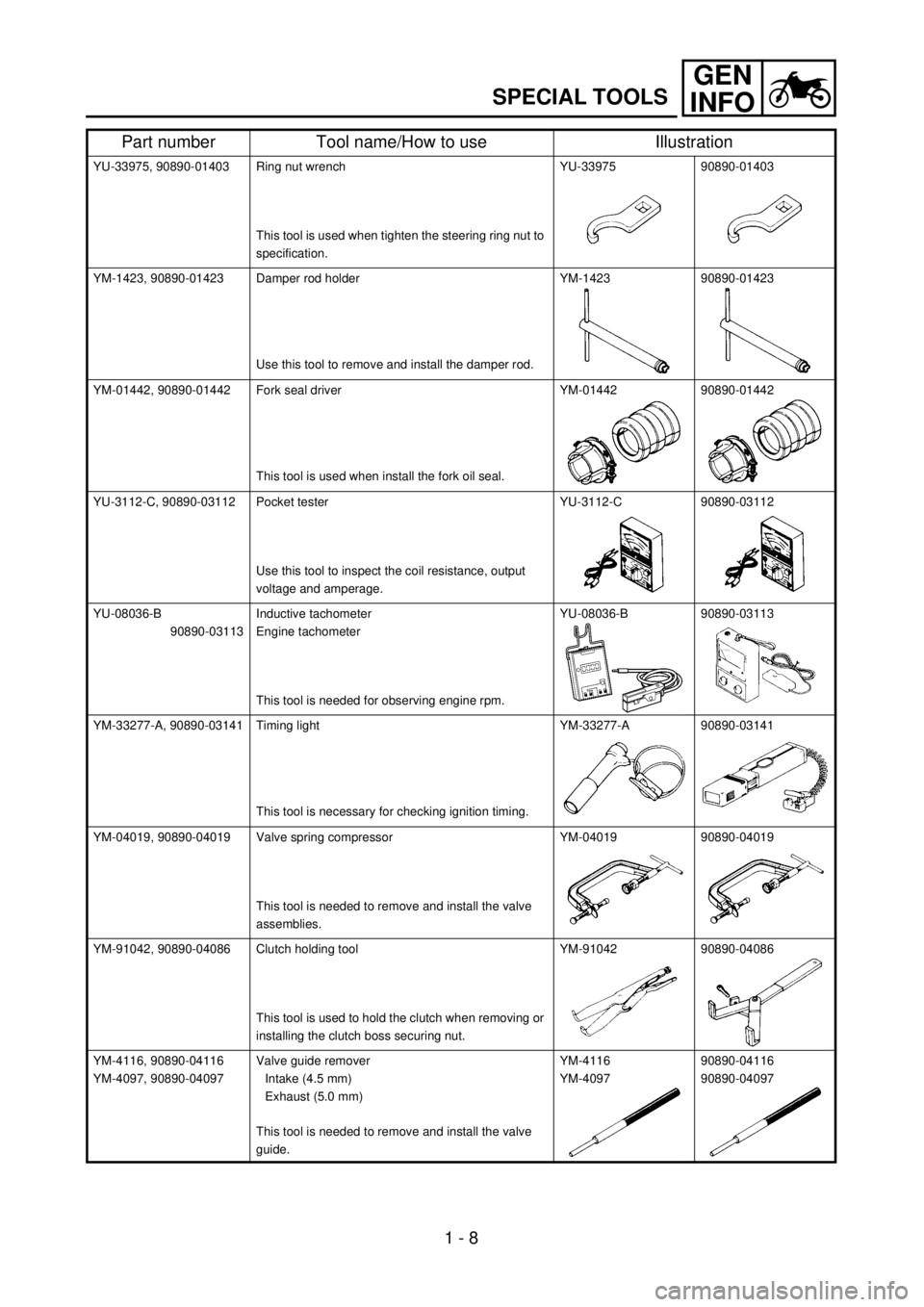
1 - 8
GEN
INFO
SPECIAL TOOLS
YU-33975, 90890-01403 Ring nut wrench
This tool is used when tighten the steering ring nut to
specification.YU-33975 90890-01403
YM-1423, 90890-01423 Damper rod holder
Use this tool to remove and install the damper rod.YM-1423 90890-01423
YM-01442, 90890-01442 Fork seal driver
This tool is used when install the fork oil seal.YM-01442 90890-01442
YU-3112-C, 90890-03112 Pocket tester
Use this tool to inspect the coil resistance, output
voltage and amperage.YU-3112-C 90890-03112
YU-08036-B
90890-03113Inductive tachometer
Engine tachometer
This tool is needed for observing engine rpm.YU-08036-B 90890-03113
YM-33277-A, 90890-03141 Timing light
This tool is necessary for checking ignition timing.YM-33277-A 90890-03141
YM-04019, 90890-04019 Valve spring compressor
This tool is needed to remove and install the valve
assemblies.YM-04019 90890-04019
YM-91042, 90890-04086 Clutch holding tool
This tool is used to hold the clutch when removing or
installing the clutch boss securing nut.YM-91042 90890-04086
YM-4116, 90890-04116
YM-4097, 90890-04097Valve guide remover
Intake (4.5 mm)
Exhaust (5.0 mm)
This tool is needed to remove and install the valve
guide.YM-4116
YM-409790890-04116
90890-04097
Part number Tool name/How to use Illustration
Page 50 of 762
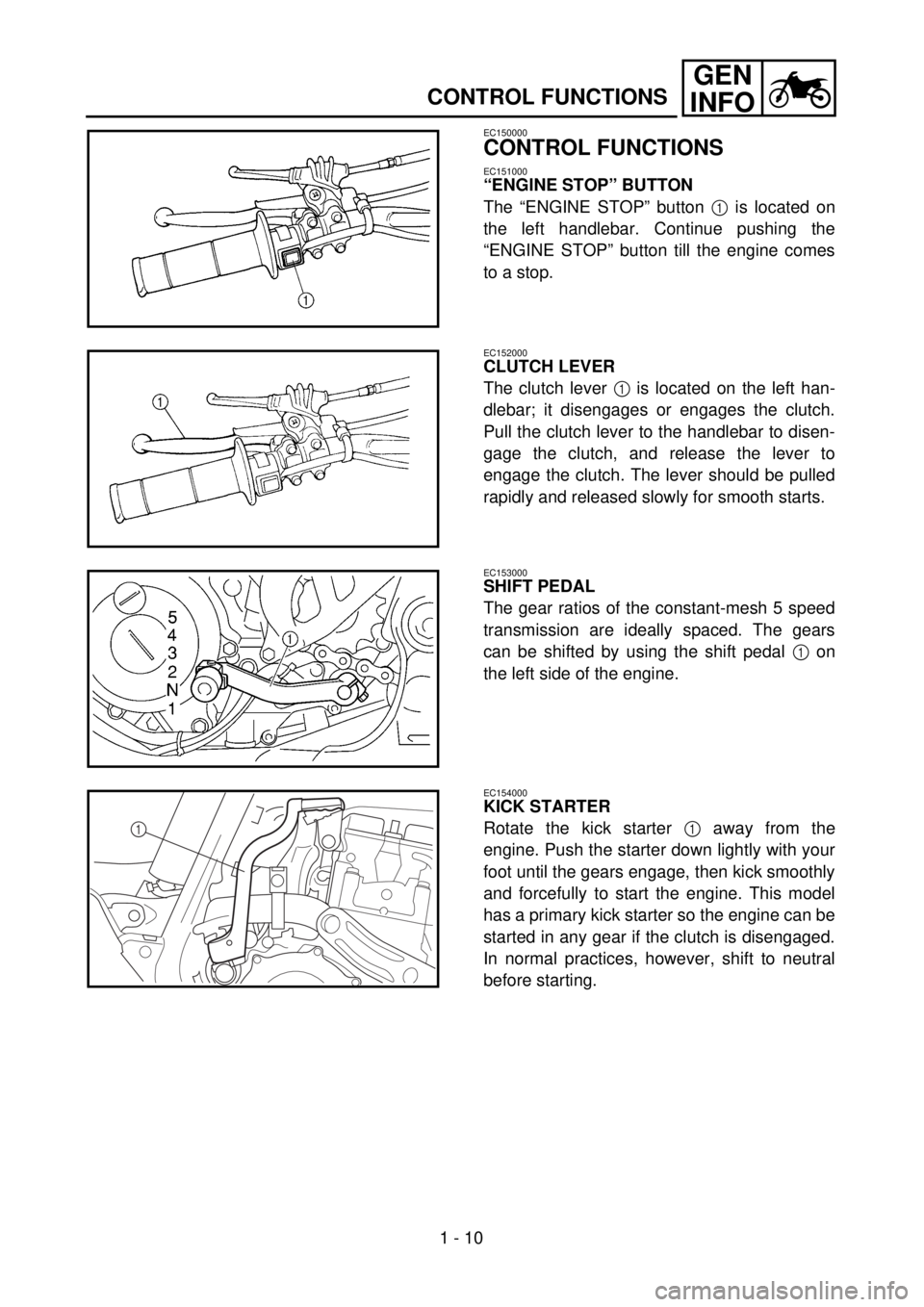
1 - 10
GEN
INFO
CONTROL FUNCTIONS
EC150000
CONTROL FUNCTIONS
EC151000
“ENGINE STOP” BUTTON
The “ENGINE STOP” button 1 is located on
the left handlebar. Continue pushing the
“ENGINE STOP” button till the engine comes
to a stop.
EC152000
CLUTCH LEVER
The clutch lever 1 is located on the left han-
dlebar; it disengages or engages the clutch.
Pull the clutch lever to the handlebar to disen-
gage the clutch, and release the lever to
engage the clutch. The lever should be pulled
rapidly and released slowly for smooth starts.
EC153000
SHIFT PEDAL
The gear ratios of the constant-mesh 5 speed
transmission are ideally spaced. The gears
can be shifted by using the shift pedal 1 on
the left side of the engine.
EC154000
KICK STARTER
Rotate the kick starter 1 away from the
engine. Push the starter down lightly with your
foot until the gears engage, then kick smoothly
and forcefully to start the engine. This model
has a primary kick starter so the engine can be
started in any gear if the clutch is disengaged.
In normal practices, however, shift to neutral
before starting.
1
Page 51 of 762

GEN
INFO
FONCTIONS DES COMMANDES
ARMATUREN UND DEREN FUNKTION
FUNCIONES DE CONTROL
ARMATUREN UND
DEREN FUNKTION
MOTORSTOPPSCHALTER “ENGI-
NE STOP”
Der Motorstoppschalter “ENGINE
STOP” 1 befindet sich auf der linken
Seite des Lenkers.
Den Motorstoppschalter “ENGINE
STOP” gedrückt halten, bis der
Motor abstirbt.
KUPPLUNGSHEBEL
Der Kupplungshebel 1 befindet sich
auf der linken Seite des Lenkers und
dient zum Ein- und Auskuppeln. Zum
Ausrücken der Kupplung den Kupp-
lungshebel zum Lenkgriff ziehen; zum
Einrücken der Kupplung den Kupp-
lungshebel wieder freigeben. Zum
Auskuppeln den Kupplungshebel
zügig ziehen, beim Einkuppeln gefühl-
voll loslassen, um ein weiches Einrük-
ken der Kupplung zu gewährleisten.
FUSSSCHALTHEBEL
Erst das Getriebe erlaubt die Nut-
zung der Motorleistung in verschie-
denen Geschwindigkeitsbereichen,
so daß Anfahren, Bergauffahren und
schnelles Beschleunigen möglich
sind. Die Gänge dieses 5-Gang-
Getriebes werden über den Fuß-
schalthebel 1 linksseitig des Motors
bei ausgerückter Kupplung geschal-
tet.
KICKSTARTER
Zum Anlassen des Motors den Kick-
starterhebel 1 ausschwenken und
langsam niedertreten, bis deutlicher
Widerstand spürbar wird; dann den
Kickstarterhebel schwungvoll durch-
treten. Dieses Modell ist mit einem
Primärkickstarter ausgerüstet, d. h.
der Motor kann auch bei eingelegtem
Gang angelassen werden – voraus-
gesetzt, daß die Kupplung ausge-
rückt ist. Normalerweise sollte
jedoch in den Leerlauf geschaltet
werden, bevor der Motor gestartet
wird.
FONCTIONS DES
COMMANDES
BOUTON D’ARRET DE MOTEUR
“ENGINE STOP”
Ce bouton d’arrêt de moteur “ENGINE
STOP” 1 est situé sur le guidon gauche.
Continuer à appuyer sur le bouton d’arrêt
de moteur “ENGINE STOP” jusqu’a que
ce le moteur s’arrête.
LEVIER D’EMBRAYAGE
Le levier d’embrayage 1 est situé sur le
guidon gauche et permet d’embrayer ou
de débrayer. Tirer le levier d’embrayage
vers le guidon pour débrayer et relâcher
le levier pour embrayer. Pour des démar-
rages doux, le levier doit être tiré rapide-
ment et relâché lentement.
PEDALE DE CHANGEMENT DE
VITESSE
Les 5 rapports de la boîte de vitesses à
prise constante sont idéalement échelon-
nés. Le changement de vitesse est com-
mandé par le sélecteur à pédale 1 situé
du côté gauche du moteur.
DEMARREUR AU PIED
Déployer la pédale de démarreur au pied
1. Appuyer légèrement sur la pédale
jusqu’à ce que les pignons se mettent en
prise puis l’actionner vigoureusement
pour démarrer le moteur. Ce modèle est
muni d’un démarreur au pied primaire,
de sorte qu’on peut démarrer sur
n’importe quelle vitesse à condition de
débrayer. Toutefois, normalement, on
remettra les vitesses au point mort avant
la mise en marche.
1 - 10
FUNCIONES DE
CONTROL
BOTÓN DE PARADA DEL MOTOR
“ENGINE STOP”
El botón de parada del motor “ENGINE
STOP” 1 está situado en el manillar
izquierdo. Pulse de forma continuada
este botón hasta que se detenga el motor.
PALANCA DEL EMBRAGUE
La palanca del embrague 1 está situada
en el manillar izquierdo; su función es la
de embragar o desembragar. Tire de la
palanca del embrague hacia el manillar
para desembragar y suelte la palanca
para embragar. Debe tirar de la palanca
rápidamente y soltarla suavemente para
obtener un arranque suave.
PEDAL DE CAMBIOS
Las relaciones de engranaje de la de la
caja de cambios de 5 velocidades de
engrane constante están óptimamente
separadas. Los engranes pueden cam-
biarse utilizando el pedal de cambios 1
en la parte izquierda del motor.
ARRANCADOR DE PEDAL
Gire el arrancador de pedal 1 hacia el
lado contrario al motor. Empuje el arran-
cador hacia abajo suavemente con el pie
hasta embragar las marchas y, a conti-
nuación, pedalee firme y uniformemente
para arrancar el motor. Este modelo
consta de un arrancador de pedal prima-
rio de forma que pueda arrancar el motor
en cualquiera de las marchas si el embra-
gue está desembragado. No obstante, en
condiciones normales, cambie a la posi-
ción de punto muerto antes de arrancar.
Page 52 of 762
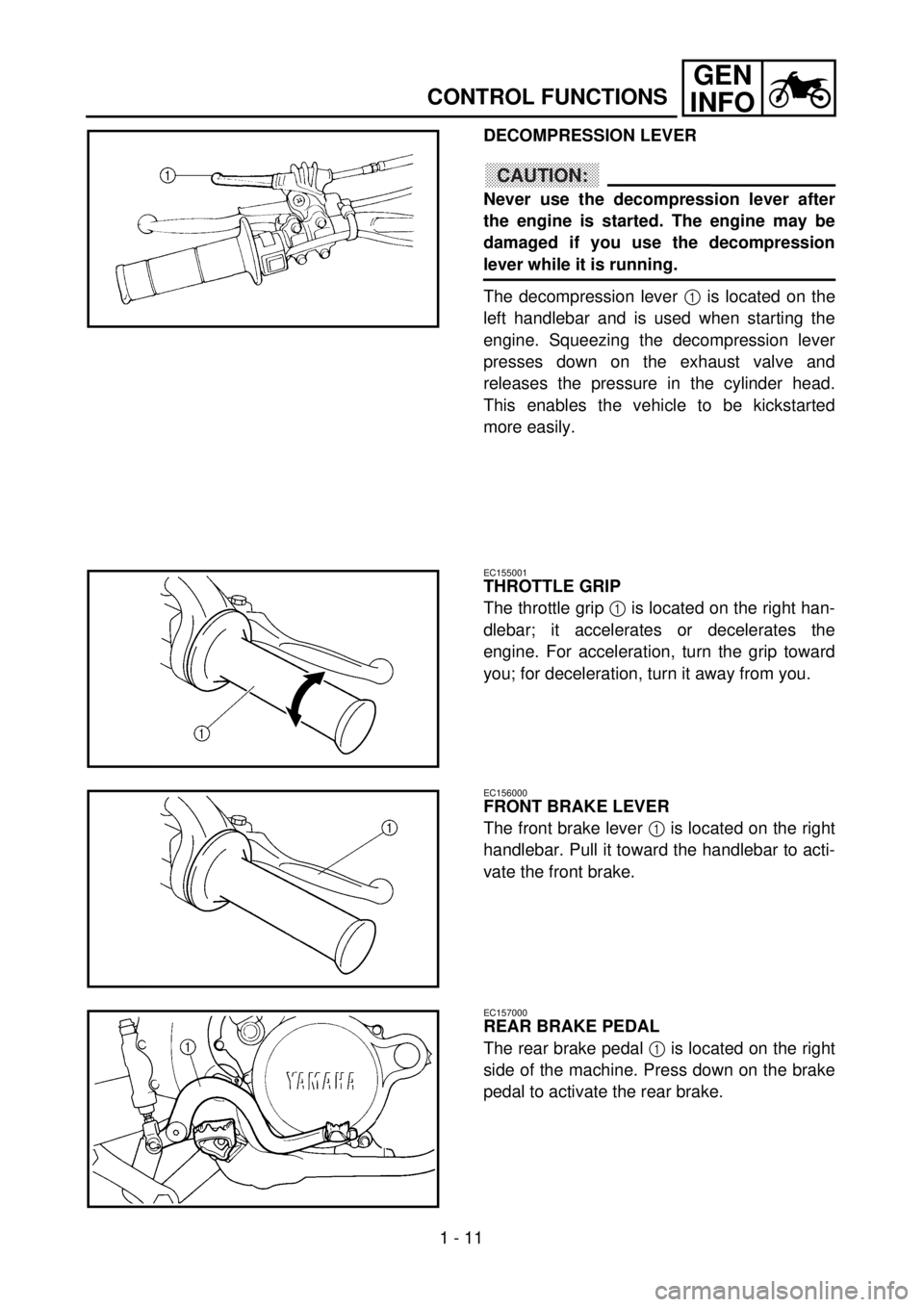
1 - 11
GEN
INFO
CONTROL FUNCTIONS
DECOMPRESSION LEVER
CAUTION:
Never use the decompression lever after
the engine is started. The engine may be
damaged if you use the decompression
lever while it is running.
The decompression lever 1 is located on the
left handlebar and is used when starting the
engine. Squeezing the decompression lever
presses down on the exhaust valve and
releases the pressure in the cylinder head.
This enables the vehicle to be kickstarted
more easily.
EC155001
THROTTLE GRIP
The throttle grip 1 is located on the right han-
dlebar; it accelerates or decelerates the
engine. For acceleration, turn the grip toward
you; for deceleration, turn it away from you.
EC156000
FRONT BRAKE LEVER
The front brake lever 1 is located on the right
handlebar. Pull it toward the handlebar to acti-
vate the front brake.
EC157000
REAR BRAKE PEDAL
The rear brake pedal 1 is located on the right
side of the machine. Press down on the brake
pedal to activate the rear brake.
Page 54 of 762

1 - 12
GEN
INFO
CONTROL FUNCTIONS
FUEL COCK
The fuel cock supplies fuel from the tank to
carburetor and also filters the fuel. The fuel
cock has three positions:
OFF:With the lever in this position fuel will not
flow. Always return the lever to this posi-
tion when the engine is not running.
ON: With the lever in this position fuel flows to
the carburetor. Normal riding is done with
the lever in this position.
RES:With the lever in this position fuel flows to
the carburetor from the reserve section of
the fuel tank after the main supply of the
fuel has been depleted. Normal riding is
possible with the lever is in this position,
but it is recommended to add fuel as
soon as possible.
COLD STARTER KNOB
When cold, the engine requires a richer air-fuel
mixture for starting. A separate starter circuit,
which is controlled by the cold starter knob 1,
supplies this mixture. Pull the cold starter knob
out to open the circuit for starting. When the
engine has warmed up, push it in to close the
circuit.
HOT STARTER KNOB (red)
The hot starter knob (red) 1 is used when
starting a warm engine.
Use the hot starter knob when starting the
engine again immediately after it was stopped
(the engine is still warm). Pulling out the hot
starter knob injects secondary air to thin the
air-fuel mixture temporarily, allowing the
engine to be started more easily.
CAUTION:
After the engine has started, be sure to
push the hot starter knob back in.
Page 58 of 762

1 - 14
GEN
INFO
STARTING AND BREAK-IN
STARTING AND BREAK-IN
WARNING
Never start or run the engine in a closed
area. The exhaust fumes are poisonous;
they can cause loss of consciousness and
death in a very short time. Always operate
the machine in a well-ventilated area.
CAUTION:
lThe carburetor on this motorcycle has a
built-in accelerator pump. Therefore,
when starting the engine, do not operate
the throttle or the spark plug will foul.
lUnlike a two-stroke engine, this engine
cannot be kick started when the throttle is
open because the kick starter may kick
back. Also, if the throttle is open the air/
fuel mixture may be too lean for the
engine to start.
lNever use the decompression lever after
the engine is started. The engine may be
damaged if you use the decompression
lever while it is running.
lBefore starting the machine, perform the
checks in the pre-operation check list.
STARTING A COLD ENGINE
1. Inspect the coolant level.
2. Turn the fuel cock to “ON”.
3. Shift the transmission into neutral.
4. Fully open the cold starter knob.
5. Without pulling in the decompression
lever, slowly depress the kick starter until
the compression stroke is found. When
considerable resistance of the kick starter
is felt, the engine is on the compression
stroke. If the engine is on the exhaust
stroke, resistance will only be felt when
the kick starter is initially depressed, not
through the entire range of depression
(as when the engine is on the compres-
sion stroke); therefore, depress the kick
starter a few more times.
Page 60 of 762
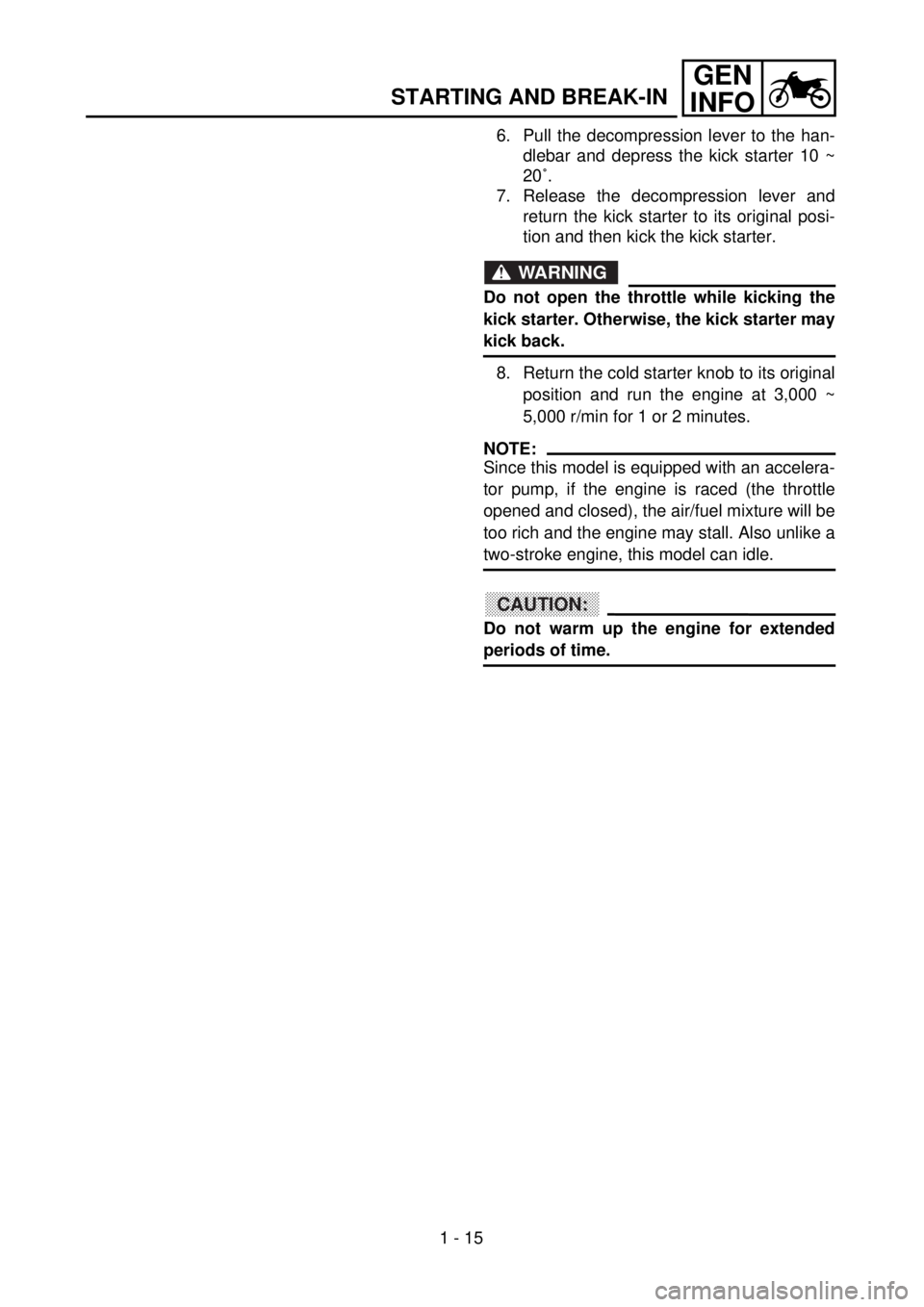
1 - 15
GEN
INFO
STARTING AND BREAK-IN
6. Pull the decompression lever to the han-
dlebar and depress the kick starter 10 ~
20˚.
7. Release the decompression lever and
return the kick starter to its original posi-
tion and then kick the kick starter.
WARNING
Do not open the throttle while kicking the
kick starter. Otherwise, the kick starter may
kick back.
8. Return the cold starter knob to its original
position and run the engine at 3,000 ~
5,000 r/min for 1 or 2 minutes.
NOTE:
Since this model is equipped with an accelera-
tor pump, if the engine is raced (the throttle
opened and closed), the air/fuel mixture will be
too rich and the engine may stall. Also unlike a
two-stroke engine, this model can idle.
CAUTION:
Do not warm up the engine for extended
periods of time.
Page 62 of 762

1 - 16
GEN
INFO
STARTING AND BREAK-IN
STARTING A WARM ENGINE
Do not operate the cold starter knob and throt-
tle. Open the hot starter knob (red) and start
the engine by kicking the kick starter forcefully
with a firm stroke.
As soon as the engine starts, push in the hot
starter knob to close the air passage.
Restarting an engine after a fall
Pull the hot starter knob (red) and start the
engine. As soon as the engine starts, push in
the hot starter knob to close the air passage.
The engine fails to start
Pull the hot starter knob (red) all the way out,
pull the decompression lever to the handlebar,
and while holding the lever, kick the kickstarter
10 to 20 times to clear the engine.
Then, restart the engine.
Refer to “Restarting an engine after a fall”.
* Operate the throttle grip before kick starting.
CAUTION:
Observe the following break-in procedures
during initial operation to ensure optimum
performance and avoid engine damage.
Throttle
grip oper-
ation*Cold
starter
knobHot
starter
knob (red)
Air temperature = less than
5 ˚C (41 ˚F)Open 3
or 4 timesON OFF
Air temperature = more
than 5 ˚C (41 ˚F)None ON OFF
Air temperature (normal
temperature) = between
5 ˚C (41 ˚F) and 25 ˚C
(77 ˚F)None ON/OFF OFF
Air temperature = more
than 25 ˚C (77 ˚F)None OFF OFF
Starting an engine after a long
period of timeNone ON OFF
Restarting a warm engine None OFF ON
Restarting an engine after a fall None OFF ON
Starting a cold engine
Page 64 of 762

1 - 17
GEN
INFO
BREAK-IN PROCEDURES
1. Before starting the engine, fill the fuel
tank with the fuel.
2. Perform the pre-operation checks on the
machine.
3. Start and warm up the engine. Check the
idle speed, and check the operation of
the controls and the “ENGINE STOP”
button. Then, restart the engine and
check its operation within no more than 5
minutes after it is restarted.
4. Operate the machine in the lower gears
at moderate throttle openings for five to
eight minutes.
5. Check how the engine runs when the
motorcycle is ridden with the throttle 1/4
to 1/2 open (low to medium speed) for
about one hour.
6. Restart the engine and check the opera-
tion of the machine throughout its entire
operating range. Restart the machine
and operate it for about 10 to 15 more
minutes. The machine will now be ready
to race.
CAUTION:
l
After the break-in or before each race,
you must check the entire machine for
loose fittings and fasteners as per
“TORQUE-CHECK POINTS”.
Tighten all such fasteners as required.
l
When any of the following parts have
been replaced, they must be broken in.
CYLINDER AND CRANKSHAFT:
About one hour of break-in operation is
necessary.
PISTON, RING, VALVES, CAMSHAFTS
AND GEARS:
These parts require about 30 minutes of
break-in operation at half-throttle or less.
Observe the condition of the engine care-
fully during operation.
STARTING AND BREAK-IN
Page 65 of 762
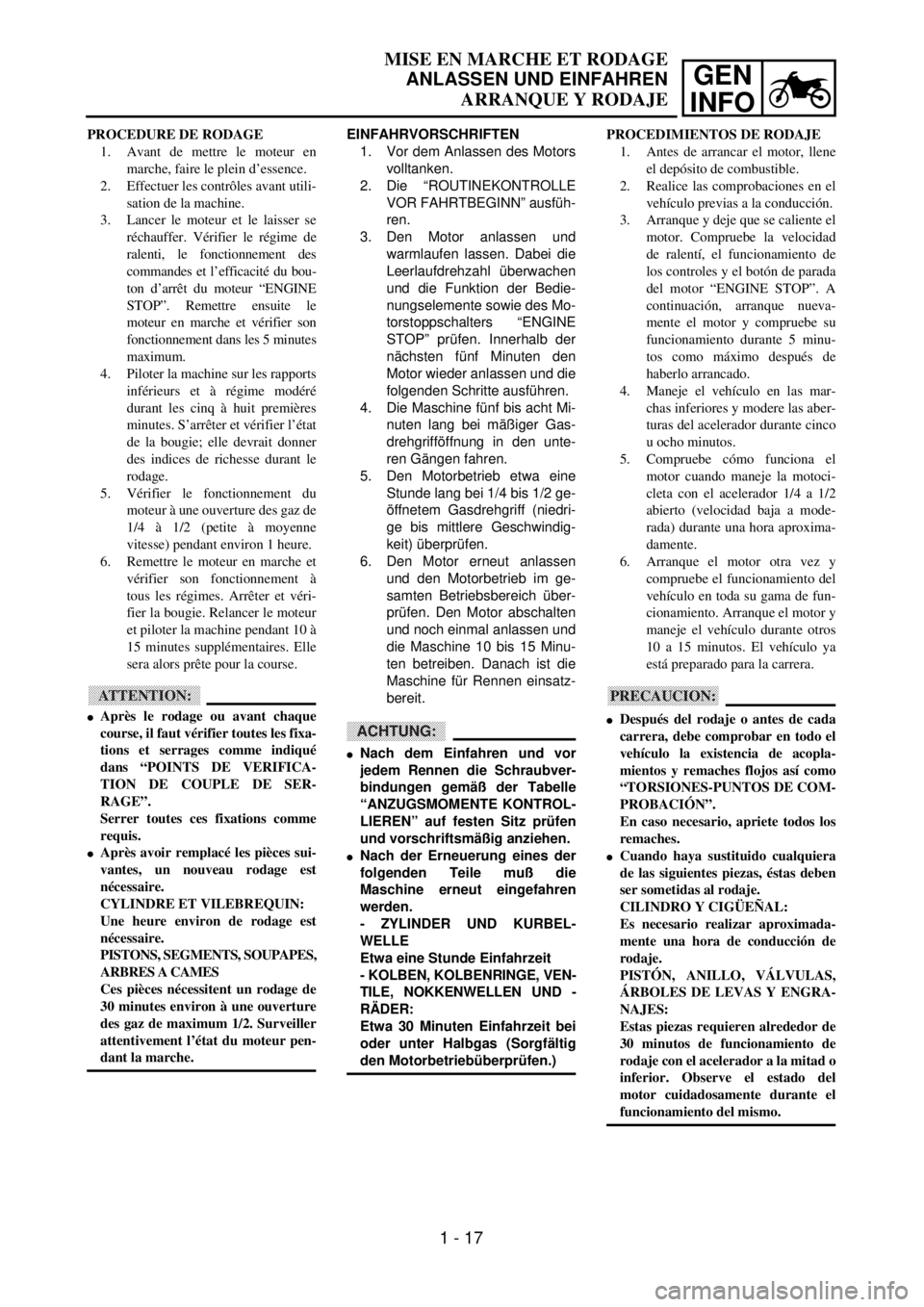
GEN
INFO
EINFAHRVORSCHRIFTEN
1. Vor dem Anlassen des Motors
volltanken.
2. Die “ROUTINEKONTROLLE
VOR FAHRTBEGINN” ausfüh-
ren.
3. Den Motor anlassen und
warmlaufen lassen. Dabei die
Leerlaufdrehzahl überwachen
und die Funktion der Bedie-
nungselemente sowie des Mo-
torstoppschalters “ENGINE
STOP” prüfen. Innerhalb der
nächsten fünf Minuten den
Motor wieder anlassen und die
folgenden Schritte ausführen.
4. Die Maschine fünf bis acht Mi-
nuten lang bei mäßiger Gas-
drehgrifföffnung in den unte-
ren Gängen fahren.
5. Den Motorbetrieb etwa eine
Stunde lang bei 1/4 bis 1/2 ge-
öffnetem Gasdrehgriff (niedri-
ge bis mittlere Geschwindig-
keit) überprüfen.
6. Den Motor erneut anlassen
und den Motorbetrieb im ge-
samten Betriebsbereich über-
prüfen. Den Motor abschalten
und noch einmal anlassen und
die Maschine 10 bis 15 Minu-
ten betreiben. Danach ist die
Maschine für Rennen einsatz-
bereit.
ACHTUNG:
lNach dem Einfahren und vor
jedem Rennen die Schraubver-
bindungen gemäß der Tabelle
“ANZUGSMOMENTE KONTROL-
LIEREN” auf festen Sitz prüfen
und vorschriftsmäßig anziehen.
lNach der Erneuerung eines der
folgenden Teile muß die
Maschine erneut eingefahren
werden.
- ZYLINDER UND KURBEL-
WELLE
Etwa eine Stunde Einfahrzeit
- KOLBEN, KOLBENRINGE, VEN-
TILE, NOKKENWELLEN UND -
RÄDER:
Etwa 30 Minuten Einfahrzeit bei
oder unter Halbgas (Sorgfältig
den Motorbetriebüberprüfen.)
MISE EN MARCHE ET RODAGE
ANLASSEN UND EINFAHREN
ARRANQUE Y RODAJE
PROCEDURE DE RODAGE
1. Avant de mettre le moteur en
marche, faire le plein d’essence.
2. Effectuer les contrôles avant utili-
sation de la machine.
3. Lancer le moteur et le laisser se
réchauffer. Vérifier le régime de
ralenti, le fonctionnement des
commandes et l’efficacité du bou-
ton d’arrêt du moteur “ENGINE
STOP”. Remettre ensuite le
moteur en marche et vérifier son
fonctionnement dans les 5 minutes
maximum.
4. Piloter la machine sur les rapports
inférieurs et à régime modéré
durant les cinq à huit premières
minutes. S’arrêter et vérifier l’état
de la bougie; elle devrait donner
des indices de richesse durant le
rodage.
5. Vérifier le fonctionnement du
moteur à une ouverture des gaz de
1/4 à 1/2 (petite à moyenne
vitesse) pendant environ 1 heure.
6. Remettre le moteur en marche et
vérifier son fonctionnement à
tous les régimes. Arrêter et véri-
fier la bougie. Relancer le moteur
et piloter la machine pendant 10 à
15 minutes supplémentaires. Elle
sera alors prête pour la course.
ATTENTION:
lAprès le rodage ou avant chaque
course, il faut vérifier toutes les fixa-
tions et serrages comme indiqué
dans “POINTS DE VERIFICA-
TION DE COUPLE DE SER-
RAGE”.
Serrer toutes ces fixations comme
requis.
lAprès avoir remplacé les pièces sui-
vantes, un nouveau rodage est
nécessaire.
CYLINDRE ET VILEBREQUIN:
Une heure environ de rodage est
nécessaire.
PISTONS, SEGMENTS, SOUPAPES,
ARBRES A CAMES
Ces pièces nécessitent un rodage de
30 minutes environ à une ouverture
des gaz de maximum 1/2. Surveiller
attentivement l’état du moteur pen-
dant la marche.PROCEDIMIENTOS DE RODAJE
1. Antes de arrancar el motor, llene
el depósito de combustible.
2. Realice las comprobaciones en el
vehículo previas a la conducción.
3. Arranque y deje que se caliente el
motor. Compruebe la velocidad
de ralentí, el funcionamiento de
los controles y el botón de parada
del motor “ENGINE STOP”. A
continuación, arranque nueva-
mente el motor y compruebe su
funcionamiento durante 5 minu-
tos como máximo después de
haberlo arrancado.
4. Maneje el vehículo en las mar-
chas inferiores y modere las aber-
turas del acelerador durante cinco
u ocho minutos.
5. Compruebe cómo funciona el
motor cuando maneje la motoci-
cleta con el acelerador 1/4 a 1/2
abierto (velocidad baja a mode-
rada) durante una hora aproxima-
damente.
6. Arranque el motor otra vez y
compruebe el funcionamiento del
vehículo en toda su gama de fun-
cionamiento. Arranque el motor y
maneje el vehículo durante otros
10 a 15 minutos. El vehículo ya
está preparado para la carrera.
PRECAUCION:
lDespués del rodaje o antes de cada
carrera, debe comprobar en todo el
vehículo la existencia de acopla-
mientos y remaches flojos así como
“TORSIONES-PUNTOS DE COM-
PROBACIÓN”.
En caso necesario, apriete todos los
remaches.
lCuando haya sustituido cualquiera
de las siguientes piezas, éstas deben
ser sometidas al rodaje.
CILINDRO Y CIGÜEÑAL:
Es necesario realizar aproximada-
mente una hora de conducción de
rodaje.
PISTÓN, ANILLO, VÁLVULAS,
ÁRBOLES DE LEVAS Y ENGRA-
NAJES:
Estas piezas requieren alrededor de
30 minutos de funcionamiento de
rodaje con el acelerador a la mitad o
inferior. Observe el estado del
motor cuidadosamente durante el
funcionamiento del mismo.
1 - 17